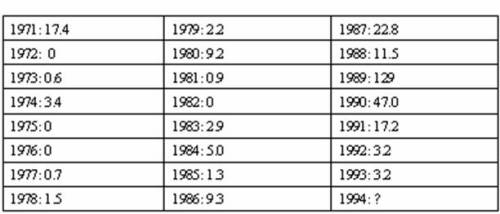First, let’s start with a fun exercise courtesy of Wilmott Magazine. Let’s look at damage estimates of earthquakes in California from 1970 to 1993 in the table below. Can you make an educated calculation of losses due to earthquakes in 1994?
Taking a look at the distribution of data, notice the low end is “0” and at high end, the most damage caused was “129.” So what’s your guess?
If you’re like me, you probably guessed wrong. Using the above numbers as an “anchor,” most people would reasonably assume that 1994’s earthquake was either an average of the above numbers or perhaps a bit higher than 129. Maybe you even threw out “129” as an outlier in the dataset. To be honest, I guessed around “200.”
The correct answer is “2217.2”! FEMA estimates that every year earthquake losses in the United States add up to $4.4 billion a year. But then, some extreme outliers can really skew that number, …
First, let’s start with a fun exercise courtesy of Wilmott Magazine. Let’s look at damage estimates of earthquakes in California from 1970 to 1993 in the table below. Can you make an educated calculation of losses due to earthquakes in 1994?
Taking a look at the distribution of data, notice the low end is “0” and at high end, the most damage caused was “129.” So what’s your guess?
If you’re like me, you probably guessed wrong. Using the above numbers as an “anchor,” most people would reasonably assume that 1994’s earthquake was either an average of the above numbers or perhaps a bit higher than 129. Maybe you even threw out “129” as an outlier in the dataset. To be honest, I guessed around “200.”
The correct answer is “2217.2”! FEMA estimates that every year earthquake losses in the United States add up to $4.4 billion a year. But then, some extreme outliers can really skew that number, especially years like 1994 where just the Northridge Earthquake in California alone tallied $20B in damage!
Let’s get back to talking turkeys via a parable from Nassim Taleb, author of the “Black Swan”. Dr. Taleb reminds us that fat, dumb and happy is probably the best way to describe the life of a turkey. They’re fed and nurtured for three years straight. Day after day, they expect the same thing. But then, one fateful day arrives and the “life” of a turkey ends quite abruptly.
Can we accurately predict the future based on reviewing and analyzing historical data? Sometimes, but we have to make assumptions of similar conditions, a normal distribution, and event independence. Complex systems will have none of these characteristics. Dr. Taleb says as much; “Real life isn’t a casino.”
Indeed, the parable of the turkey and the earthquake loss estimation exercise show us that predicting the future in complex systems can be a futile exercise because there are so many unknowns, changing conditions, and inter-connecting relationships. Extreme events that carry a huge impact happen, and some would argue they’re happening a whole lot more often as interlocking financial markets and globalization become commonplace.
Should prediction exercises be avoided? Nassim Taleb would argue otherwise: “We need to start thinking of the inconceivable,” he says. And while we cannot determine the exact probability of tomorrow’s events, we can “get a general idea about the possibility of their occurrence.”
And that’s where scenario planning comes into play. Bill Ziemba, author of the aforementioned Wilmott Magazine article says, “Getting all the scenarios and their probabilities right is impossible and doesn’t matter much anyway. What is important is to cover the board of possible occurrences. Then you will make sound decisions with risk under control.”
The fact is, like the turkey, we just don’t know what tomorrow will bring. So, plan for the five to seven most likely occurrences and then develop contingencies based on those scenarios. French microbiologist Louis Pasteur says it best: “In the fields of observation chance favors only the prepared mind.”
For a turkey, today may appear like any other “normal” day. However, tomorrow could be the chopping block.
Questions:
- Nassim Taleb says, “It is only in very rare circumstances that probability (by itself) is a guide to decision making.” Does this mean that historical data analysis isn’t worth the effort?
- If chance favors the prepared mind, what’s the “next unexpected twist” that marketers should be looking for?
